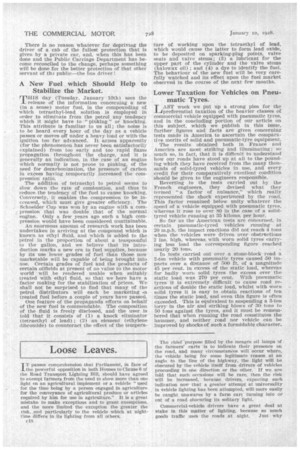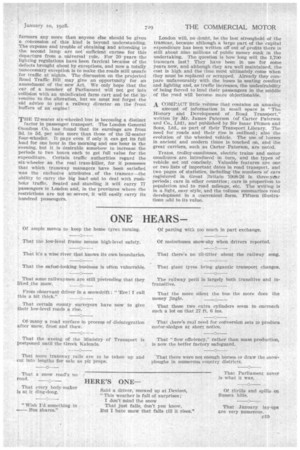Loose Leaves.
Page 40

Page 41

If you've noticed an error in this article please click here to report it so we can fix it.
IT passes comprehension that Parliament, in face of the powerful opposition in both Houses to Clause 6 of the Road Transport Lighting Bill, should have agreed to exempt farmers from the need to show more than one light on an agricultural implement or a vehicle "used for the time being by a person engaged in agriculture for the conveyance of agricultural produce or articles required by him for use in agriculture." It is a great mistake to make exceptions and to 'grant exemptions, and the more limited the exception the greater the risk, and particularly to the vehicle which at nighttime differs in its lighting from all others.
c18
The chief purpose filled 'by the meagre oil lamps of the farmers' carts is to indicate their presence on the road, and many circumstances will occur where, the vehicle being for some legitimate reason at an angle to the line of the highway, the light will be obscured by the vehicle itself from drivers of vehicles proceeding in one direction or the other, if we are told that such occasions will be rare, then the risk will be increased, because drivers, expecting such indication now that a greater attempt at universality in vehicle lightinghus been attempted, will more easily be caught unawares by a farm cart turning into or out of a road obscuring its solitary light.
Commercial-vehicle drivers have a great deal at stake in this matter of lighting, because so much goods traffic uses the roads at night, Just why'
farmers any more than anyone else should be given a concession of this kind is beyond understanding. The expense and trouble of obtaining and attending to the second lamp are not sufficient excuse for this departure from a universal rule. For 20 years the lighting regulations have been farcical because of the defects brought about by exceptions, and now a totally unnecessary exception is to make the roads still unsafe for traffic at nights. The discussion on the projected Road Traffic Bill may give an opportunityfor an amendment of the new Act. We only hope that the ear of a member of Parliament will not get into collision with an nnindicated farm cart and be the incentive to the alteration, but we must not forget the old advice to put a railway director on the front buffers of an engine!
THE 72-seater six-wheeled bus is becoming a distinct factor in passenger transport. The London General Omnibus Co. has found that its earnings are from 3d. to 5d. per mile more than those of the 52-seater four-wheeler. It pays even if only it can get its full load for one hour in the morning and one hour in the evening, but it is desirable somehow to increase the periods to two hours each to get full value for the expenditure. Certain traffic authorities regard the six-wheeler as the real tram-killer, for it possesses that which tramway managers have been satisfied was the exclusive attributes of the tramcar—the ability to carry the big load and to deal with rush
hour Seated and standing it will carry 77 passengers in London and, in the provinces where the restrictions are not so severe, it will easily carry its hundred passengers.
London will, no doubt, be the last stronghold of the tramcar, because although a large part of the capital expenditure has been written off out of profits there is Still about nine millions of public money sunk in the undertaking. The question is how long will the 1,700 tramcars last? They have been in use for some years now, and although they are well maintained, the cost is high and the time must ultimately come when they must be replaced or scrapped. Already they compare unfavourably with the buses in seating comfort and lighting and, as traffic increases, the undesirability of being forced to land their passengers in the middle of the road will become more objectionable.
A COMPACT little volume that contains an amazing athount of information in small space is "Time History and Development of Road Transport," written by -Mr. James Paterson (of Carter Paterson and Co., Ltd), and published by Sir Isaac Pitman and Sons, Ltd., as part of their Transport Library. The need for roads and their risss.is outlined ; also the evolution of the wheeled vehicle. The use of horses in ancient and modern times is touched on, and the great carriers, such as Carter Paterson, are noted.
Trams, trolley-omnibuses, electric trains and motor omnibuses are introduced in turn, and the types of vehicle set out concisely. Valuable features are one or two lists of important dates in road transport, and two pages of statistics, including the numbers of cars registered In Great Britain 1908-26 in three-yestr periods; cars in other countries; cars in proportion. to population and to road mileage, etc. The writingis in a light, easy style, and the volume summarizes road development in a convenient form. Fifteen illustrations add to its value.












































































































